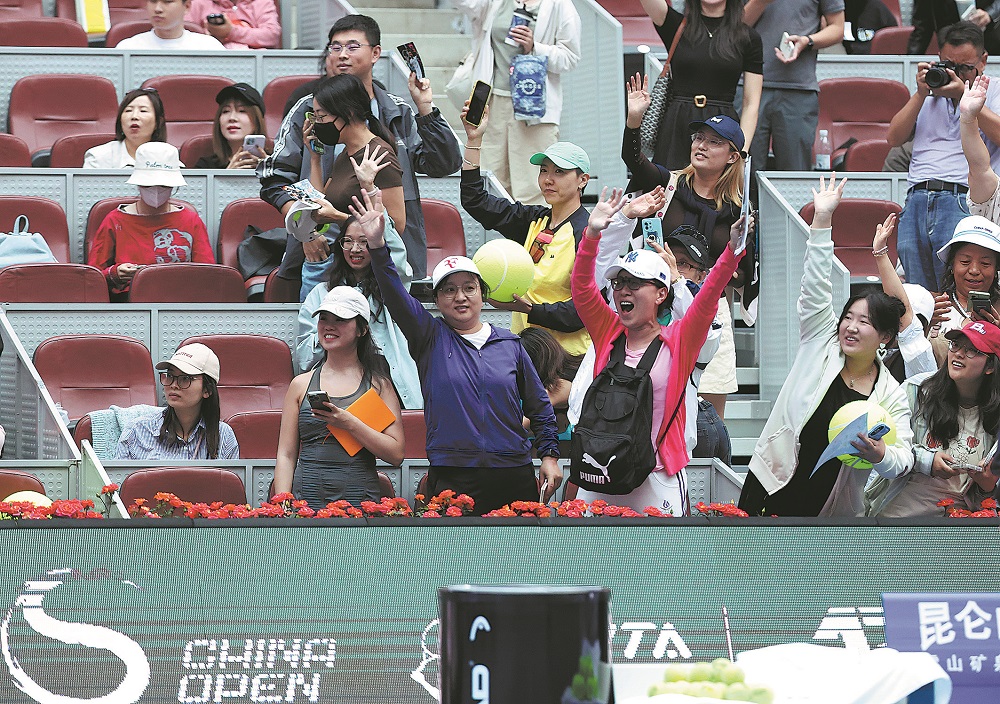
As China pushes ahead with its sports industry upgrade, the expansion of the women's professional tennis circuit has served it up a boost by opening up more business opportunities in the sports entertainment sector.
Already a busy stretch on the pro tennis calendar, the annual "China Swing" has got bigger and better this year, with five new WTA 125 events added in the country, anchored by a beyond-its-class leg in Suzhou, Jiangsu province. Combined, they are expected to further elevate the sport's profile, offer local talent more competitive playing time and boost consumption in relevant businesses.
The inaugural Suzhou Open, which swings off its main draw action on Sept 29 at the Sungent International Tennis Center, features an above-average field for a tournament on the entry-level WTA circuit, with all the 23 direct entries in the singles draw ranked within the top-100, and four of whom are inside the top-50.
Slovakia's world No 35 Rebecca Sramkova, the French Open's homegrown semifinalist Lois Boisson (No 46) and the Philippines' rising star Alexandra Eala (No 75) will spearhead the 32-player singles draw, where four qualifiers, four wild-card entries and one special exemption will fill up the remaining spots.
China's current third-highest ranked woman Yuan Yue (No 100), two-time major quarterfinalist Zhang Shuai and former world No 47 Wang Yafan are among a competitive legion of home aces coveting main-draw appearances, either through wildcards or as alternates.
"In terms of the quality of the field, I think it's safe to say that we are almost as competitive as some of the tournaments on the Tour's next level," tournament director Zhou Yunsong said at the launch ceremony of the Suzhou Open on Friday.
"We didn't expect it, to be honest, that so many high-ranking players have signed up to play at a WTA 125 event here.
"I think it all came down to the collective qualities of service and facilities, as well as the accessibility of not just one or two, but a string of events in China that has made a greater number of international players want to come every year."
With six Tour-level tournaments already on the schedule, China is hosting a total 11 WTA events this fall, with the 125-level drills serving up a launchpad for the country's ambitious newcomers to progress to the top-tier stage, such as the WTA 1000-level China Open and Wuhan Open.
Scheduled prudently to maximize playing and earning opportunities, the WTA 125 circuit, which has mushroomed to 50 legs this year, up from 24 in 2022, and offers a total prize pool of $6 million, has also provided a stepping stone for established players returning from injury and maternity leave as they transition back to the pro stage.

"This is the first WTA event to be held in Jiangsu province, and we hope to build a stage for all the up-and-coming players to launch the pursuit of their professional dreams," Helene He, WTA Asia-Pacific director of operations, said of the Suzhou event's purpose.
"We'd like to also develop it into a sports entertainment event during the National Day holiday that will benefit local tourism and cultural promotion."
Built on the picturesque shore of Yangcheng Lake, the Sungent tennis center hosts 11 courts, including nine featuring the same hard surface as the Australian Open and two covered by the same red clay used at the French Open, across an area of 8,788 square meters.
Four of the courts are equipped with all-weather retractable roofs to ensure uninterrupted training and matches if necessary, while a new four-star hotel, with breathtaking views of the lake and the tennis center, is within walking distance of the center court.
A fitting addition
The Suzhou Open was launched just one day after China's central government issued a set of guidelines on Thursday aimed at unleashing the consumption potential in sports-related businesses to drive the high-quality development of the sports industry.
At the core of the 20-measure guideline, which was issued by the State Council, is a desire to diversify and expand the supply of sporting events as an entertainment product for consumers who are not necessarily sports fans.
Tourism, accommodation, sales of club merchandise and youth training in relevant sports are among areas where consumption potential could be further tapped with the hosting of more sports events, according to the guideline.
Specific proposals also include the development of the outdoor sports industry, boosting the snow-and-ice economy around operations of mountain resorts and indoor rinks and upgrading the manufacturing sector of sporting goods.
China plans to cultivate a number of sports enterprises and sporting events with global influence, build a full-fledged sports industry worth 7 trillion yuan (about $985 billion) by 2030, per the guideline.
The new guideline reflects the country's goal to leverage sports events as a driver of economic growth in a variety of businesses, and the increasing number of pro tennis events being held in China, for instance, is setting an example, according to Bai Xilin, director of the tennis administration center under the General Administration of Sport of China.
"The more tournaments being hosted, the bigger the slice of the pie," Bai said at a recent media event to reveal a series of measures to promote the "China Swing" as a whole.
"Week in, week out, tennis tournaments will help generate revenues from ticket sales, retail, catering and tourism, among other businesses, from one city to another."
All of the tournaments to be held in China over the next two months are expected to attract a total of one million spectators, generating a collective revenue of over 2 billion yuan, according to an estimate by the center.


